Professional Tips for Making Use Of a Rain Gauge to Monitor Resident Weather Conditions
Professional Tips for Making Use Of a Rain Gauge to Monitor Resident Weather Conditions
Blog Article
Unveiling the Science Behind Rain Evaluates: Exactly How These Tools Play a Vital Function in Environment Research Study and Ecological Tracking
Rain gauges, relatively basic tools, hold a profound value in the world of environment study and environmental monitoring. These plain tools silently gather one of nature's most necessary components-- rainfall. Yet, behind their plain exterior exists a complicated science that is essential for recognizing the dynamics of our setting. As we peel off back the layers of this scientific shroud surrounding rain assesses, we uncover a world where precision, information accuracy, and meticulous monitoring converge to introduce a deeper understanding of our changing environment and its effect on the earth.
Value of Rain Scales
Rainfall evaluates play a crucial function in monitoring and gauging rainfall levels, providing essential information for climate study and analysis. These gadgets are basic in measuring the quantity of rains that takes place in a particular area over a particular period. By gauging and collecting rain, rain evaluates deal important insights into the distribution and intensity of precipitation, helping meteorologists, hydrologists, and climatologists in recognizing weather patterns and patterns.
Among the crucial reasons why rainfall evaluates are important is their ability to give localized and exact information. Unlike satellite or radar-based measurements, which offer more comprehensive monitorings, rainfall evaluates offer precise details specific to the area where they are put. This localized data is essential for different applications, consisting of flood projecting, drought tracking, and water resource management. Additionally, long-term information accumulated from rain determines assists in examining climate adjustment impacts and patterns, adding dramatically to clinical research and decision-making procedures. In essence, rain assesses act as necessary tools in the area of meteorology and environmental scientific research, playing a vital duty ahead of time our understanding of climate and environment characteristics.
Kinds Of Rainfall Gauges

Capability and Procedure
In the realm of environment research study and meteorological research studies, the effectiveness of rainfall gauges lies in their intricate performance and accurate functional systems. Rain determines are designed to precisely gauge the amount of precipitation that drops over a particular area during a collection duration.
The performance of rainfall assesses is based upon the concept of accumulating and measuring rainwater in a standard manner. This collected data is vital for understanding local weather condition patterns, tracking lasting climate fads, and examining ecological effects. To make sure precise dimensions, rain gauges demand to discover this be tactically positioned in open areas away from obstructions such as buildings or trees that can hinder the collection procedure.
The operational facet of rainfall assesses involves normal maintenance to stop debris buildup, calibration checks to preserve dimension precision, and data tape-recording for evaluation (rain gauge). On the whole, the performance and procedure of rainfall evaluates are crucial for gathering trustworthy rainfall data vital to environment research study and ecological surveillance
Function in Climate Research
Given the vital relevance of accurate rainfall dimensions in recognizing weather patterns and ecological impacts, the duty of rainfall assesses in climate study is important. Rain evaluates give essential data for climate research by quantifying the amount of precipitation that falls over a certain area during a given period. This information is crucial for keeping an eye on lasting trends in rainfall patterns, evaluating the effect of climate modification on rainfall circulation, and enhancing climate versions.

Climate researchers use information accumulated from rain evaluates to evaluate variants in rainfall levels, recognize local environment fads, and examine the performance of water source monitoring strategies. By contrasting historic precipitation information with present dimensions, scientists can find shifts in rainfall patterns, such as changes in the regularity or intensity of rains events. This details is crucial for comprehending just how climate adjustment is influencing rainfall dynamics and can assist policymakers make informed choices pertaining to adjustment and reduction methods.
Applications in Ecological Surveillance

In flood forecasting, rainfall gauge information assists to track rains strength and distribution, allowing authorities to issue prompt warnings and take needed steps to alleviate flood threats (rain gauge). Dry spell surveillance relies on rain scale data to analyze dampness degrees in the dirt and track rainfall deficits, aiding in the identification of drought-prone areas and the execution of dry spell action approaches
Moreover, rainfall scale information plays a vital duty in water source management by giving info on water accessibility and use trends. In addition, in farming, rain scale data assists farmers in enhancing watering schedules, plant choice, and total farm management methods based on neighborhood precipitation patterns.
Conclusion
Finally, rain gauges are necessary tools for measuring rainfall, supplying useful data for environment research study and ecological official source surveillance. With numerous kinds and performances, rainfall assesses play a crucial role in understanding rainfall patterns and their influence on the environment. By properly measuring rainfall, these tools contribute to the development of clinical understanding and aid in making informed decisions pertaining to water source administration and catastrophe readiness.
Rain assesses play an essential role in tracking and determining rainfall levels, offering essential data for environment research and evaluation. The standard rain scale, known as the "tipping bucket" gauge, is one anchor of the most commonly utilized tools. Ultrasonic rain gauges usage noise waves to detect the visibility of rain, providing real-time information on precipitation degrees.Climate scientists make use of data gathered from rainfall determines to analyze variations in precipitation levels, determine local environment trends, and evaluate the performance of water source monitoring techniques.In conclusion, rainfall assesses are necessary tools for measuring precipitation, giving valuable information for climate research study and environmental monitoring.
Report this page